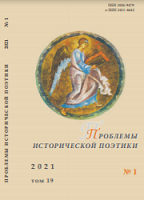Рождественская стихира «Днесь Христос» и ее круг подобия: греко-славянские параллели (X-XVII вв.)
Christmas Sticheron “Σήμερον ὁ Χριστός” and Circle of Its Prosomoia: Greek-Slavonic Parallels of the 10th-17th Centuries
Author(s): Irina V. Gerasimova, Nina B. Zakharina, Nadezhda A. ShchepkinaSubject(s): Christian Theology and Religion, Music, Russian Literature, 6th to 12th Centuries, 13th to 14th Centuries, 16th Century, 17th Century
Published by: Петрозаводский государственный университет
Keywords: historical poetics; hymnography; podoben of the second level; comparative analysis; Greek sing; Kievan sing; Old Russian singing art;
Summary/Abstract: The subject of article is the history of the musical and poetic composition of the Christmas sticheron “Σήμερον ὁ Χριστός” by Johann Damascene with the Gospel quotation “Glory to God in the highest, and on earth peace, and good will toward men” (Lk. 2:14), as well as the circle of associated stichera in Byzantine, Old Russian and Kiev-Lithuanian traditions. The musical text of the hymns is represented in Greek manuscripts by Chartres, Coislin and middle-Byzantine neumes; Old Russian chant books were analyzed using znamenny neumes and singer notation; and Kiev manuscripts - using Kievan five-line notation records. The melody of the Christmas sticheron emphasizes the importance of the Gospel quotation with long melismatic musical fragments of the quotation itself and the previous sentence. This sticheron became a model for several hymns to Epiphany, Purification of the Most Holy Mother of God, Annunciation and Entry into the Temple of the Most Holy Mother of God, the majority of which were excluded from liturgical use. There are various ways of creating a new sticheron based on the model: prosomoion may be a calque or an independent composition with certain elements of model tune. The latter case of the sticheron to the Entry into the Temple “Σήμερον τῷ ναῷ προσάγεται” has its own musical text history in three traditions, independent from that of the model. Chants of Old Russian manuscripts of 11th-14th centuries are similar to those of a Byzantine origin, but in the 15th-17th centuries the music of these two traditions has developed in different ways. The Kievan chant tradition, similar to both Old Russian and Byzantine ones, is a point of intersection of chant cultures.
Journal: Проблемы исторической поэтики
- Issue Year: 19/2021
- Issue No: 1
- Page Range: 55-74
- Page Count: 20
- Language: Russian

